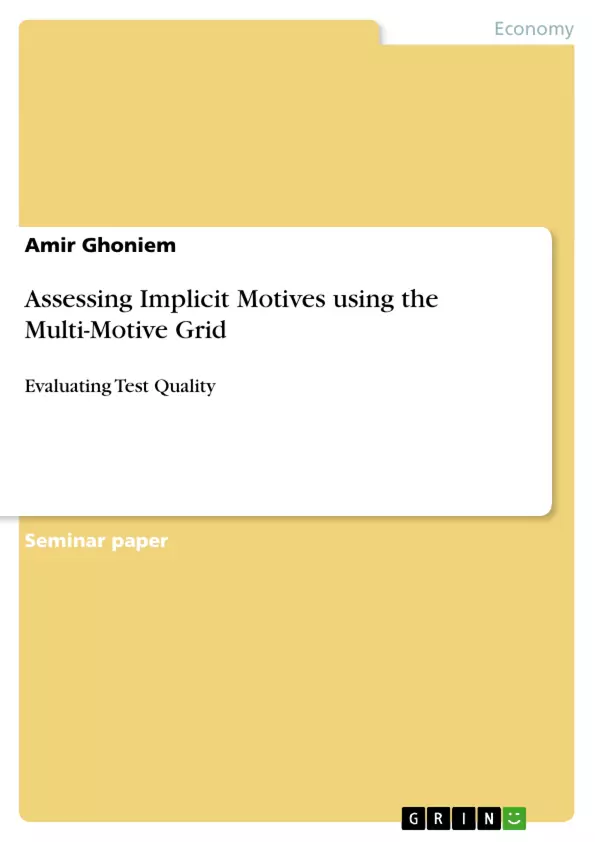The Multi-Motive Grid (MMG) is a new instrument to measure implicit motives (Sokolowski,
Schmalt, Langens & Puca, 2000). Schmalt (Schmalt, 1976) has developed the Grid-technique
in order to combine the advantages of self-reports and projective tests (e.g. the TAT). Schmalt
(1999) labeled these instruments “semi-projective”. Early semi-projective tests have measured
all three implicit motives separately which made it necessary to use three different tests in
order to assess all implicit motives. The MMG is an advancement of these single instruments
and measures all three big implicit motives with their two components at once.
In difference to the TAT subjects do not have to write down a story but have to tick
statements which are listed underneath each picture. Subjects have to decide whether
statements fit to the depicted picture or not. The decision whether a motive-relevant statement
fits to the picture or not, should be influenced by the implicit motives of the subject. Thus
comparable to the TAT, it is expected that the pictures activate the implicit motive and one
can conclude from the interpretation of the pictures on the implicit motives of the subject.
Also comparable to the TAT, subjects are confronted with ambigious pictures which often can
be interpreted in an achievement-thematic, power-thematic and affliation-thematic way. In
each statement, the subject have to decide whether the statement fits to the picture or not,
although only the Yes-responses are considered in the calculation of the motive scores. The
statements are considered to assess all three big implicit motives with both the Fearcomponent
and the Hope-Component. Although the pictures can be interpreted in different
ways, some pictures stimulate one motive more than the other. There are two pictures for each
component which stimulate all three motives (polythematic), two pictures for each component
which stimulate only two of the three motives (bithematic) and two pictures for each
component which assess only one motive (monothematic). The MMG thus consists 14
pictures. The motive content of the pictures were ascertained by informing subjects about
implicit motives and explicitly asking them (N=41) to rate the pictures on all three motives.
Afterwards the mean of ratings for all pictures was calculated (Schmalt et. al, 1994).
Inhaltsverzeichnis (Table of Contents)
- Introduction
- Empirical Analysis of the MMG
- Objectivity
- Reliability
- Retest Reliability
- Internal Consistency
- Distortedness of the MMG
- Construct Validity
- Intercorrelations of the Motive-components
- Factorial Validity
- Convergent and Divergent Validity
- Criterion Validity
- Discussion
- References
- Appendix: Checklist for Evaluating the MMG
Zielsetzung und Themenschwerpunkte (Objectives and Key Themes)
This document provides a comprehensive analysis of the Multi-Motive Grid (MMG), a new instrument designed to measure implicit motives. The primary objective is to evaluate the test quality of the MMG, assessing its reliability, validity, and objectivity. The document also explores the potential for distortedness and the instrument's robustness against social desirability.
- Assessment of the MMG's test quality
- Analysis of the MMG's reliability, including retest reliability and internal consistency
- Evaluation of the MMG's construct validity, examining intercorrelations, factorial validity, convergent and divergent validity, and criterion validity
- Investigation of the MMG's objectivity and its potential for distortedness
- Exploration of the MMG's robustness against social desirability
Zusammenfassung der Kapitel (Chapter Summaries)
The introduction provides an overview of the MMG and its development as a semi-projective instrument designed to measure implicit motives. It contrasts the MMG with traditional projective tests like the TAT and highlights its unique features, such as its closed-response format and the use of pictures to activate implicit motives.
The chapter on objectivity discusses the MMG's adherence to the principles of the Classical Test Theory and details how objectivity is achieved through standardized administration, evaluation, and interpretation. The document emphasizes the importance of standardized testing procedures and clear instructions for scoring and interpreting the results.
The chapter on reliability examines the retest reliability and internal consistency of the MMG. It presents data showing that the MMG demonstrates good to very good retest reliability and that the internal consistency coefficients suggest a successful strategy for measuring multiple motives with different components.
The chapter on distortedness explores the potential for the MMG to be influenced by social desirability. The analysis demonstrates that the MMG appears to be robust against social desirability, as there were no significant correlations between motive scores and scores on the Crowne-Marlowe Scale for Social Desirableness.
Schlüsselwörter (Keywords)
The primary keywords and focus topics of this document include implicit motives, Multi-Motive Grid (MMG), test quality, reliability, validity, objectivity, distortedness, social desirability, and the Classical Test Theory.
- Citar trabajo
- Amir Ghoniem (Autor), 2011, Assessing Implicit Motives using the Multi-Motive Grid, Múnich, GRIN Verlag, https://www.grin.com/document/210664



